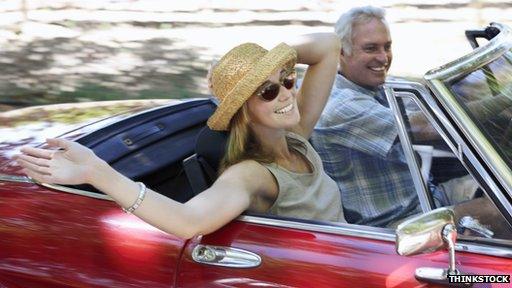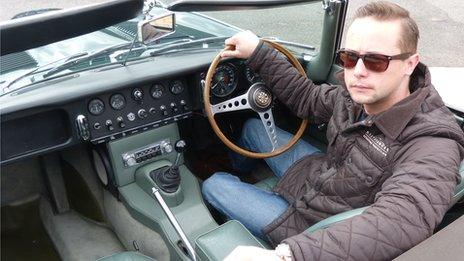Topless fun: How to buy a convertible on a budget
- Published

Just as Britons are the fastest to expose their flesh when the thermometer touches 20C, so they are among the greatest enthusiasts for convertible cars.
It seems they are even more likely to buy a convertible than the fashion-conscious French, or the car-crazy Italians, even though both countries have a far better claim on sunshine.
Nevertheless, the popularity of convertible cars, or soft-tops, has been falling in the UK since new purchases peaked in 2004.
Yet gone are the days of damp seats, excessive wind noise and a heavy insurance premium.
So is now the time to "slip in to something more convertible", as one advertisement suggestively invites us?
And more to the point, can anyone on a modest income actually afford one?
'Head and heart'
Now is the time of year when the urge to feel the wind and the sun on your face begins to insinuate itself.
You imagine motoring through glorious British countryside, pausing only to picnic in fields of bright yellow rapeseed, or by a flowing mountain stream.
And it is for that reason that now is precisely the wrong time of year to buy a convertible.
On the basis of supply and demand, soft-tops are now at their most expensive.
Even new ones are likely to be cheaper around Christmas, when dealers will often have a sale to get rid of stock.
"I wouldn't buy a convertible now," says Philip Nothard of the car data provider CAP.
"I'd wait until October. It's head and heart," he says.
Most customers do the opposite, of course, buying in the spring and selling in the autumn.
Costs
CAP has worked out the 10 cheapest convertibles to run on a monthly basis, taking depreciation, servicing, maintenance and fuel economy into account.
Their calculations are based on three years' ownership, doing 12,000 miles a year, and excludes diesel versions.
They found the key expense is not just the purchase price, but how much you get back when you come to sell it: the depreciation.
For that reason, buyers are also advised to choose a standard colour, such as white, which is more popular in the second-hand market.
And the cheapest new convertible to buy is not necessarily the cheapest car to drive.
So the Fiat 500C is the second cheapest on the list, but it is the most economical to run.
Furthermore, insurance costs may not be as high as you think.
Using the example of a teacher living in North London, insuring a Fiat 500C can cost as little as £19 a year more than a conventional car.
Insurance companies do not penalise soft-top owners specifically, unless a particular model is prone to theft.
"In many cases, a convertible car may cost less to insure than a regular vehicle," said a spokesman for Admiral insurance.

Ben Speak says many convertibles, like this 1966 E Type, do not depreciate
Air con
An alternative to buying a new soft-top is to go for a classic, old-fashioned model.
And while classic cars are likely to cost more in terms of maintenance and servicing, they can be just as economical overall.
While new cars always depreciate over time, classic cars can often do the opposite.
Ten years ago, a Mercedes SL Pagoda would have sold for about £40,000. Now it is worth up to £100,000.
"You're not going to make loads of money, but you're not going to lose money," says Ben Speak, sales director for the restoration company Hilton and Moss.
For those on a budget, he recommends an MGB Roadster, which can cost as little as £10,000 and is relatively cheap to service.
"It's not the preserve of city boys and bankers," he says.
But convertibles do not suit everyone of course, especially if you like your comforts.
As one motor industry expert put it: "If you like that wind in your hair stuff, why not just turn on the air conditioning?"
- Published9 May 2014
.jpg)